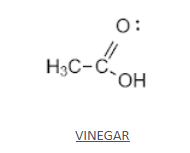
Draw structural formula for each of the following compounds:
Vinegar
Answer
453.9k+ views
Hint Structural formula identifies the location of chemical bonds between the atoms of a molecule. They are particularly useful for showing how compounds with the identical kind and number of atoms differ.
Complete answer:
- The structural formula or the molecular formula of an organic compound shows every bond between every atom within the molecule.
- A structural formula consists of symbols for the atoms connected by short lines that represent chemical bonds—one, two, or three lines standing for single, double, or triple bonds, respectively.
- The structural formula of vinegar is shown below

- Organic compounds, from any of the large classes of chemical compounds having one or more atoms of carbon are covalently linked to atoms of other elements, usually hydrogen, oxygen, or nitrogen.
-The few carbon-containing compounds not classified as organic include carbides, carbonates, and cyanides.
- Therefore, Vinegar is described as an organic compound, with the functional group carboxylic acid.
Additional information:
The main source of the carbon in organic compounds is carbon dioxide in the atmosphere. Plants use sunlight to convert carbon dioxide and water, which is an inorganic-compound, into sugar (an organic compound) through the process of photosynthesis.
Note: Carbon has four valence electrons, which means that each carbon atom can form a maximum of four bonds with other atoms. And due to the number of bonds that carbon can form with other atoms, organic compounds are often very complex.
Complete answer:
- The structural formula or the molecular formula of an organic compound shows every bond between every atom within the molecule.
- A structural formula consists of symbols for the atoms connected by short lines that represent chemical bonds—one, two, or three lines standing for single, double, or triple bonds, respectively.
- The structural formula of vinegar is shown below

- Organic compounds, from any of the large classes of chemical compounds having one or more atoms of carbon are covalently linked to atoms of other elements, usually hydrogen, oxygen, or nitrogen.
-The few carbon-containing compounds not classified as organic include carbides, carbonates, and cyanides.
- Therefore, Vinegar is described as an organic compound, with the functional group carboxylic acid.
Additional information:
The main source of the carbon in organic compounds is carbon dioxide in the atmosphere. Plants use sunlight to convert carbon dioxide and water, which is an inorganic-compound, into sugar (an organic compound) through the process of photosynthesis.
Note: Carbon has four valence electrons, which means that each carbon atom can form a maximum of four bonds with other atoms. And due to the number of bonds that carbon can form with other atoms, organic compounds are often very complex.
Recently Updated Pages
Glucose when reduced with HI and red Phosphorus gives class 11 chemistry CBSE

The highest possible oxidation states of Uranium and class 11 chemistry CBSE

Find the value of x if the mode of the following data class 11 maths CBSE

Which of the following can be used in the Friedel Crafts class 11 chemistry CBSE

A sphere of mass 40 kg is attracted by a second sphere class 11 physics CBSE

Statement I Reactivity of aluminium decreases when class 11 chemistry CBSE

Trending doubts
10 examples of friction in our daily life

The correct order of melting point of 14th group elements class 11 chemistry CBSE

Difference Between Prokaryotic Cells and Eukaryotic Cells

One Metric ton is equal to kg A 10000 B 1000 C 100 class 11 physics CBSE

State and prove Bernoullis theorem class 11 physics CBSE

What organs are located on the left side of your body class 11 biology CBSE




